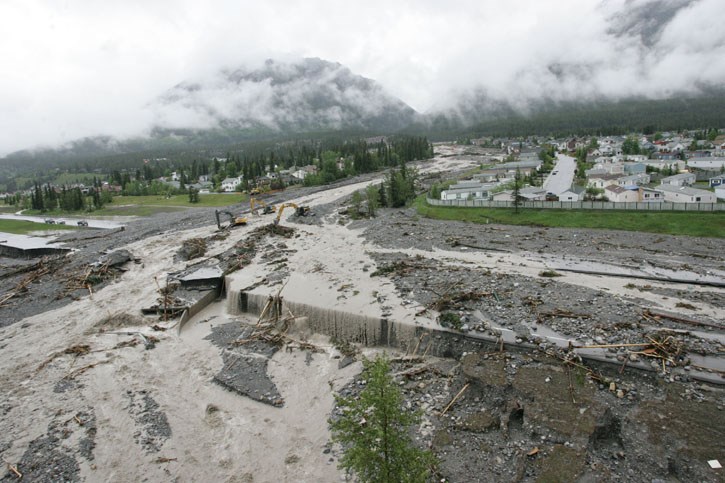CANMORE – More than five years have passed since the skies above Canmore opened up and soaked the community, causing mountain creeks to swell with debris and water, but the community remained without long-term mitigation for the most affected neighbourhood of Cougar Creek.
On Thursday (Nov. 15), the municipality moved one major step closer to beginning to install a proposed $48 million debris retention structure along Cougar Creek after the Natural Resources Conservation Board (NRCB) announced the project is in the public interest.
In a press release, the NRCB board announced it had concluded the structure will protect public safety, property and infrastructure with no unacceptable impacts on the environment or wildlife, and it has approved the application.
The approval also requires the Town of Canmore to implement reclamation and re-vegetation management of construction-related issues, ongoing water monitoring and continued access to backcountry recreation areas during and after construction.
The application was submitted in July 2016 to the NRCB and Alberta Environment and Parks (AEP) and an environmental impact assessment (EIA) for the project was deemed complete in April this year.
Project manager Felix Camire said at the time the province undertakes a thorough review of the application and EIA – which was 1,200 pages when submitted – the terms of reference and makes followup requests for supplemental information before it is considered complete.
The NRCB engaged in a public feedback process this spring as well, however it did not hold public hearings into the application.
Even with several years invested into the approval process, there is still another two regulatory processes required, which are an application under the Water Act for the structure to be build and a land disposition agreement with AEP.
The debris retention structure, or debris dam, is designed to prevent debris flows or debris floods from inundating Cougar Creek, which is the most densely developed alluvial fan in Canada. It would hold back up to 650,000 cubic metres of water and sediment. It will be 29.85-metres tall and 45-metres wide and is estimated to cost $48 million.
In 2013, Cougar Creek dumped 90,000 cubic metres of debris on the fan as a result of significant rainfall in the Bow Valley. At the Elk Run culvert, the flow rate estimated during the flood was 80-110 cubic metres per second during the debris flood event.
After the flood, the Town of Canmore undertook a comprehensive risk and hazard assessment on all mountain creeks that drain into the community, with a focus on Cougar Creek, as there were significant values in place due to the development of that area. The hazard-based approach looks at possible flood scenarios that might happen, whereas a risk-based approach analyzes how much human life is at risk, as well as infrastructure.
“The floods of 2013 demonstrated the limitations of hazard-based mitigation for protecting Canmore from debris flows and debris floods generated by our steep mountain creeks,” stated the EIS preface. “Lacking adequate mitigation for the magnitude of this event, tens of millions in losses were experienced, highways and the railway were severed, and public and emergency response teams were put at risk.”
The assessment of the steep creeks includes more than just a single return period for a flood event. The full range of hazards are considered and while the 2013 Cougar Creek flood was a rare event, larger and more significant debris flood events could occur.
While the pricetag for the debris dam is $48 million, the municipality has already secured the funds to proceed once approvals are in place. That includes $4 million from the Town of Canmore, $14 million from the federal government, and $30.7 million from the province of Alberta.




